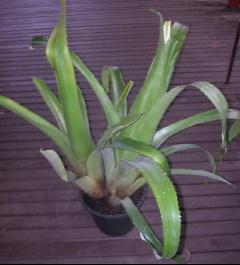
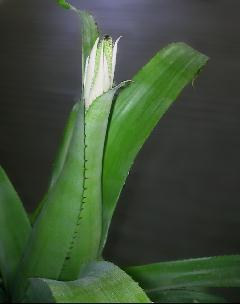
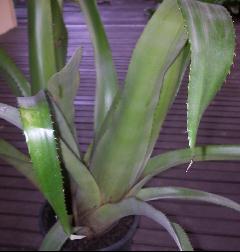
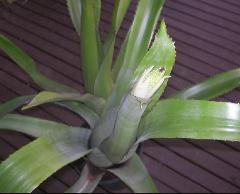
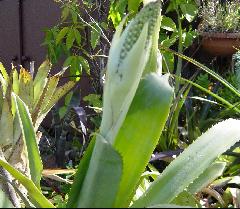

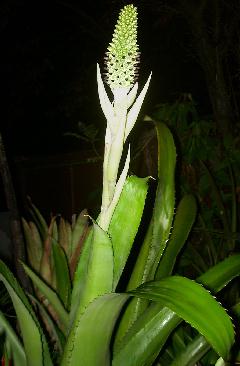
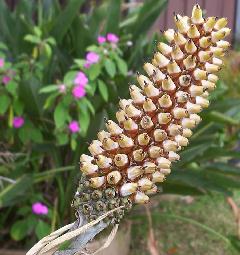
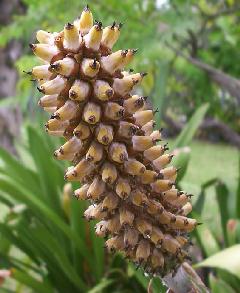
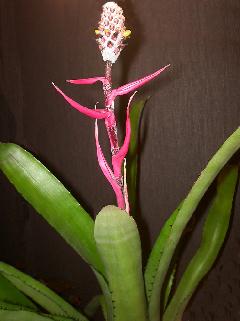
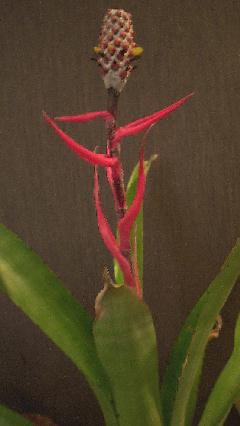
Aechmea bromeliifolia var. bromeliifolia
Type: Guiana Francesa, s.d., Martin s.n. (Holotype BM! photo).
Basionym: Tillandsia bromeliaefolia Rudge, Pl. Guian. 32, t. 50. 1807.
= Macrochordion bromeliifolia (Rudge) Beer in L.B.Sm. & WJ.Kress, Phytologia 66(1): 77. 1989. H.E. Luther & E. Sieff, Selbyana 15(1): 65. 1994, pro syn.
= Aechmea lagenaria Mez, in Martius, Eichler & Urbain, Fl. Bras. 3(3): 372. 1892. Type: Brazil, viii.1884, Morren Hortus s. n. (Holotype LG! photo), syn. nov.
= Aechmea bromeliifolia var. angustispica Philcox, Kew Bull. 47(2): 268, 270. 1992. Type: Brazil, Bahia, 27.5 km south-east de Morro do Chapeu, on road to Mundo Novo, i.1977, Storr 145 (Holotype CEPEC!, Isotype K! photo), syn. nov.
Plus from S&D
Bromelia melanantha Ker, Bot. Reg. 9: pl. 766. 1824. Type. Trinidad, Lambert Hortus s n (n v), or by description and plate.
Billbergia clavata Lindley, Bot. Reg. 13: sub pl. 1068. 1827; nomen illegitimum, substitute for Bromelia melanantha Ker.
Bromelia tinctoria Martius in Spix & Martius, Reise in Brasilien 2: 554. 1828. Type. Contendas, Minas Gerais, Brazil, Martius s n (M, photo US), 1818.
Tillandsia vestita Willdenow ex Schultes filius in Roemer & Schultes, Syst. 7(2): 1228. 1830. Type. Para, Brazil, Hoffmannsegg s n (B).
Billbergia tinctoria (Martius) Martius ex Schultes filius in Roemer & Schultes, Syst. 7(2): 1256. 1830.
Macrochordion tinctorium (Martius) Vriese, Jaarb. Nederl. Maatsch. Tuinb. for 1853: 14. 1853.
Aechmea melanacanta Vriese, Tuinb.-Fl. 1: 356.1854.
Macrochordium melananthum (Ker) Beer, Bromel. 146. 1856.
Macrochordium bromeliaefolium (Rudge) Beer, Bromel. 146. 1856.
Macrochordium pulchrum Beer, Bromel. 147. 1856. Type. Paris Hortus s n (B, photo B 1192/30).
Macrochordium strictum Beer, Bromel. 147. 1856. Type. Beer Hortus s n (B ? n v), or description.
Macrochordium macracanthum Regel, Gartentlora 35: 297. 1886. Type. Brazil, Glaziou in Petrograd Hortus s n (LE ? n v), or description and plate.
Aechmea conspicuiarmata Baker, Handb. Bromel. 67. 1889; substitute name for Macrochordium macracanthum Regel, non Aechmea macracantha Brongniart ex LeBele, 1880.
Aechmea macroneottia Baker, Handb. Bromel. 68. 1889. Type. Goias to Cuiaba, Central Brazil, Weddell s n (P).
Aechmea tinctoria (Martius) Mez, Mart. Fl. Bras. 3(3): 373. 1892.
Aechmea pulchra (Beer) Mez, Mart. Fl. Bras. 3(3): 374. 1892.
Hoiriri bromeliaefolia (Rudge) Kuntze, Rev. Gen. 3(3): 303. 1898.
Nidularium macracanthum Durand & Jackson, Ind. Kew Suppl. 1: 293. 1903; error for Macrochordium macracanthum Regel.
Aechmea eriostachya Ule, Bot. Jahrb. 42: 197. 1908. Type. Maracas, Bahia, Brazil, Ule 7028 (B, photo F 11312), Sep 1906.
Aechmea ellipsoidea Rusby, Mem. N. Y. Bot. Gard. 7: 212.1927. Type. Asunto, Sur Yungas, La Paz, Bolivia, 0. E. White 633 (NY).
Aechmea bromeliifolia var renaudii Mez, Pflanzenreich IV. 32: 166. 1935; nomen.
Aechmea bromeliifotia var rubra M. B. Foster, Bromel. Soc. Bull. 12: 34. 1962. Type. Conceicao, Minas Gerais, Brazil, Foster 629 (US), 12 Ju1 1940.
LEAF SHEATHS with adaxial surface vinaceous or purpureous, abaxial surface green or sometimes reddish.
LEAF BLADES concolorous green or concolorous reddish, sometimes with abaxial surface reddish and adaxial surface green, margins serrate or sparsely serrate; spines black or sometimes reddish, 0.3-1 cm long.
INFLORESCENCE with peduncle vinaceous or dark purple; peduncle bracts pink.
FLORAL BRACTS vinaceous or purplish.
SEPALS green or yellow-greenish.
PETALS yellow or yellow-greenish.
Distribution and habitat: Aechmea bromeliifolia var. bromeliifolia occurs from Central America (Mexico, Guatemala, El Salvador and Honduras), to northwest of South America (Guianas, Suriname, Trinidad and Tobago, Venezuela, Colombia, Peru, Bolivia) and Brazil (Maranhao, Ceara, Bahia, Minas Gerais, Sao Paulo, Tocantins, Goids, Mato Grosso, Amapa, Roraima, Pard, Amazonas and Rondonia states and in Distrito Federal (Fig. 6).
It grows at 140-1700 m altitude, in Amazonian campinas and terra firme forests, semi-deciduous forests, savannas (cerrados), rocky grasslands (campos rupestres) and caatinga vegetation.
Conservation status: Least Concern (IUCN, 2001).
Notes: With one of the widest geographical distributions within Bromelioideae, A. bromeliifolia var. bromeliifolia is the best represented taxon of the complex in herbarium collections. This taxon also presents an extensive list of synonyms. Here, we kept the 14 taxonomic synonyms considered by Smith & Downs (1979) and propose two more: A. bromeliifolia var. angustispica (see previous discussion) and A. lagenaria (a synonym of A. lamarchei prior to this study). This last is justified because A. lagenaria shows many typical characters of A. bromeliifolia (e.g. leaf spines > 3 mm and truncate floral bracts) that are not founded in A. lamarchei. Despite the great morphological variation of some vegetative structures (e.g. rosette and leaf shape), A. bromeliifolia var. bromeliifolia is delimited by a set of reproductive characters, including flowers 1.4-1.6 cm long, densely lanate, depressed ovate floral bracts, with truncate or truncate emarginate apices and yellow petals with fimbriate ligulae at the distal end of the lateral folds (Fig. 5B, C, E). This species also resembles A. triangularis in having leaf spines ≥ 3 cm, emarginate, symmetric to slightly asymmetric sepals, connate to the middle, and spatulate petals with emarginated apices (Fig. 5D, E).
Aechmea bromeliifolia var. albobracteata Philcox, Ashingtonia 1(8): 92. 1974 (Fig. 10E, F)
Type: Brazil, Mato Grosso, 1 km E do km 264, estrada Xavantina-Cachimbo, 12°49'S, 51°46'W, 21.iii.1968, Philcox & Ferreira 4605 (Holotype K! photo).
LEAF SHEATHS with adaxial surface vinaceous or purpureous, abaxial surface green.
LEAF BLADES concolorous green, margins serrate; spines black, 3-6 mm long.
INFLORESCENCE with peduncle green; peduncle bracts white.
FLORAL BRACTS green.
SEPALS green.
PETALS yellow greenish.
Distribution and habitat: Aechmea bromeliifolia var. albobracteata occurs from Argentina and Paraguay to central, south and south-eastern Brazil, in Mato Grosso, Mato Grosso do Sul, Minas Gerais, Sao Paulo and Parana states (Fig. 6). It grows at 100-900 m altitude, in semi-deciduous forest, cerrados and campos rupestres.
Conservation status: Least Concern (IUCN, 2001).
Notes: In the taxonomic treatment for Aechmea subgenus Macrochordion, Smith & Downs (1979) disregarded the relevance of white peduncle bracts for the recognition of A. bromeliifolia var. albobracteata, and this type specimen was included in the list of examined material for A. bromeliifolia var. bromeliifolia. Almost all herbarium material listed as A. bromeliifolia var. albobracteata in this study was previously identified as var. bromeliifolia. In revising specimen identifications, besides the colour of the peduncle bracts, we also considered information about peduncle and floral bract coloration and the geographical origin of the specimen.
Aechmea bromeliifolia (Rudge) Baker in Bentham & Hooker filius, Gen. Pl. 3: 664. 1883.
Tillandsia bromeliaefolia Rudge, Pl. Guian. 32, pl. 50. 1807.
Bromelia melanantha Ker, Bot. Reg. 9: pl. 766. 1824. Type. Trinidad, Lambert Hortus s n (n v), or by description and plate.
Billbergia clavata Lindley, Bot. Reg. 13: sub pl. 1068. 1827; nomen illegitimum, substitute for Bromelia melanantha Ker.
Bromelia tinctoria Martius in Spix & Martius, Reise in Brasilien 2: 554. 1828. Type. Contendas, Minas Gerais, Brazil, Martius s n (M, photo US), 1818.
Tillandsia vestita Willdenow ex Schultes filius in Roemer & Schultes, Syst. 7(2): 1228. 1830. Type. Para, Brazil, Hoffmannsegg s n (B).
Billbergia tinctoria (Martius) Martius ex Schultes filius in Roemer & Schultes, Syst. 7(2): 1256. 1830.
Macrochordion tinctorium (Martius) Vriese, Jaarb. Nederl. Maatsch. Tuinb. for 1853: 14. 1853.
Aechmea melanacanta Vriese, Tuinb.-Fl. 1: 356. 1854.
Macrochordium melananthum (Ker) Beer, Bromel. 146. 1856.
Macrochordium bromeliaefolium (Rudge) Beer, Bromel. 146. 1856.
Macrochordium pulchrum Beer, Bromel. 147. 1856. Type. Paris Hortus s n (B, photo B 1192/30).
Macrochordium strictum Beer, Bromel. 147. 1856. Type. Beer Hortus s n (B ? n v), or description.
Macrochordium macracanthum Regel, Gartentlora 35: 297. 1886. Type. Brazil, Glaziou in Petrograd Hortus s n (LE ? n v), or description and plate.
Aechmea conspicuiarmata Baker, Handb. Bromel. 67. 1889; substitute name for Macrochordium macracanthum Regel, non Aechmea macracantha Brongniart ex LeBele, 1880.
Aechmea macroneottia Baker, Handb. Bromel. 68. 1889. Type. Goias to Cuiaba, Central Brazil, Weddell s n (P).
Aechmea tinctoria (Martius) Mez, Mart. Fl. Bras. 3(3): 373. 1892.
Aechmea pulchra (Beer) Mez, Mart. Fl. Bras. 3(3): 374. 1892.
Hoiriri bromeliaefolia (Rudge) Kuntze, Rev. Gen. 3(3): 303. 1898.
Nidularium macracanthum Durand & Jackson, Ind. Kew Suppl. 1: 293. 1903; error for Macrochordium macracanthum Regel.
Aechmea eriostachya Ule, Bot. Jahrb. 42: 197. 1908. Type. Maracas, Bahia, Brazil, Ule 7028 (B, photo F 11312), Sep 1906.
Aechmea ellipsoidea Rusby, Mem. N. Y. Bot. Gard. 7: 212.1927. Type. Asunto, Sur Yungas, La Paz, Bolivia, 0. E. White 633 (NY).
Aechmea bromeliifolia var renaudii Mez, Pflanzenreich IV. 32: 166. 1935; nomen.
Aechmea bromeliifotia var rubra M. B. Foster, Bromel. Soc. Bull. 12: 34. 1962. Type. Conceicao, Minas Gerais, Brazil, Foster 629 (US), 12 Ju1 1940.
Desc from S&D
Plant 7-9 dm high.
Leaves 12-20 in a tubular rosette, 6-12 dm long, covered with a membrane of white coalesced scales;
Sheaths ovate to elliptic-oblong, 1-3 dm long, usually much broader than the blade and very distinct, entire or with a few teeth toward the apex;
Blades ligulate, very variable, from acuminate to naturally rounded apiculate even on the same plant or rounded-emarginate by decay of the point, 4-9 cm wide, green or rarely red, concolorous, laxly serrate with antrorse spines to 1 cm long.
Scape erect, stout, densely white-lanate;
Scape-bracts lance-ovate, acute, entire, thin, densely and finely pale-lepidote, the upper ones densely imbricate, the lower sometimes a little shorter than the internodes.
Inflorescence simple, densely spicate, fertile throughout, ellipsoid or cylindric, to 15 cm long, 3-4 cm in diameter, densely white lanate with only the petals exposed at first.
Floral bracts broader than long, truncate, thick, coriaceous, 2-keeled, enfolding the ovary, much shorter than the sepals.
Sepals suborbicular, 7 mm long, coriaceous, equally short-connate;
Petals erect, oblong, emarginate, 15 mm long, greenish yellow, soon turning black, bearing 2 fimbriate scales well above the base;
Ovary tomentose; placentae apical; ovules long-caudate.
Type. Martin s n (holotype, BM; photo GH), French Guiana.
Distribution. Epiphytic, saxicolous, and terrestrial, from near sea level to 1585 m alt, Central America to Argentina.
GUATEMALA. Peten: Uaxactun, 1931, Bartlett 12338 (MICH); 12786 (MICH); Yaxha to Remate, Jun 1933, Lundell 4275 (MICH); Tikal, 1959, Lundell 15624 (LL, US); 16110 (LL, US). BRITISH HONDURAS. El Cayo: Mountain Pine Ridge, 7 May 1931, Bartlett 13053 (MICH). HONDURAS. Morazan: Las Mesas, 28 Feb 1947, L. 0. Williams & Molina 12122 (EAP, US). El Paraiso: Ojo de Agua, 27 Feb 1947, Standley 4720 (F). COLOMBIA. Magdalena: Pueblo Bello, Sierra Nevada de Santa Marta, Aug 1946, Foster & Smith 1465 (GH). Meta: Sierra Macarena, 25 Nov 1949, Philipson, Idrobo & Fernandez 1570(BM); 26 Dec 1949, Philipson & Idrobo 1948 (BM, US); Rio Guejar to Cano Gaupayita, Dec 1950. Idrobo & Schultes 779 (COL); Renjifo Massif, Sierra Macarena, 1950-51, Idrobo & Schultes 925 (COL, US). VENEZUELA. Distrito Federal: Caracas, Dec 1935, Pittier 13653 (US, VEN). Aragua. Colonia Tovar, 1854-55, Fendler 1352 (GH); Maracay, 1933, C. Vogl 1062 (M). Zulia: Machiques to Colon, 22 Aug 1967, Steyermark & Fernandez 99591 (VEN). Apure: San Camilo, 30 Mar 1968, Steyermark, Bunting & Blanco 101619 (VEN). Bolivar: Salto de Auraima, Rio Paragua, 10 Apr 1943, Killip 37339 (GH, US); Ptari-tepui, Nov 1944, Steyermark s n (GH); Salto Hacha, Rio Carrao, upper Rio Caroni, 6° 15' N, 62° 51' W, Mar 1954, Cardona 2890 (US); El Palmar, Sierra Imataca, 12 Dec 1960, Steyermark 87984 (NY, US, VEN); Miamo, Hato de Nuria, 25 Jan 1961, Steyermark 88852 (NY, US, VEN); km 147 south of El Dorado, 21 Dec 1970, Steyermark & Dunsterville 104194 (US, VEN). Amazonas: Cerro Cipapo (Paraque), 2 Feb 1949, Maguire & Politi 28786 (NY , US); Santa Cruz, Rio Atavi on Rio Atabapo, 9 Sep 1960, Foldats 3821 (VEN). TRINIDAD. Aripo, 8 Apr 1869, Trinidad Botanic Garden 2002 (TRIN); 12 Sep 1873, 698 (TRIN); Arima, Apr 1874, Kuntze 988 (NY, US); Carapichaima, 23 Mar 1892, Alexander s n (GH, TRIN); Balandra, St. Andrew, Mar 1922, Freeman s n (TRIN); Quare Reservoir, Valencia, 11 May 1933, Broadway s n (GH); Sangre Grande, 9 May 1955, Aitken & Downs s n (US). GUYANA. Schomburgk 1025 (K). Demerara: upper Demerara River, 1887, Jenman 4056 (BRG, K); 4153 (NY). Berbice: Maperma Creek, Corentyne River, Sep 1879, im Thurn s n (K). Essequibo, upper Mazaruni River: Kamakusa, 1922, Leng 385 (NY); Partang River mouth, 23 Jun 1960, Maguire 45905 (NY, US). SURINAME: Cottica, Lawa River, Versteeg 280 (U); upper Tapahoni River, Versteeg 607 (U); upper Gran River, Hulk 207 (U); upper Coppename River, Boon 1230 (U); Tafelberg, Geyskes 972 (U); Maguire 24276 (NY); upper Tangimama River, Mennega 487 (U); Wilhelmina Mountains, Stahel 7125 (U); Ju11963, Maguire et al 53996 (NY); 54258 (NY); 54333 (NY); 29 Aug 1963, Irwin et al 55153 (NY, US); Martin Cree, Maratakka River, Stahel & Gonggryp 231 (U); Wonotobo, Rombouts 103 (U); Paramaribo, 2 Oct 1948, Foster 2388 (US); Mapane Creek, Suriname River, 1953, Lindeman 4485 (U, US); 16 Jan 1961, Kramer & Hekking 2668 (U). FRENCH GUIANA. Poiteau s n (K); Mount Trois Pitons, Oldeman B-2622 (P). PERU. Huanuco: Rio Pachitea, Oct 1942, Sandeman 3473 (K). BOLIVIA. La Paz, Sur Yungas: San Bartolome, Calisaya, Ju11939, Krukoff 10248 (GH, NY). Santa Cruz, Chiquitos: Santiago, 3 Sep 1942, Cutler 7035 (GH). BRAZIL. Amazonas: Rio Xiborem, Luetzelburg 22013 (M); Manaus, 17 Apr 1963, Rodrigues & Coelho 13966 (INPA, US); 19 Dec 1966, Prance et al 3736 (NY); Rio Brancinho mouth, Rio Cuieras, Rio Negro basin, 29 Sep 1971, Prance et al 15038 (NY); Rio Cunhua, 6° 43' S, 66° 47' W, 28 Nov 1971, Prance et al 16471 (NY). Rondonia: Nova Vida to Porto Velho, 20 Sep 1962, Duarte 7028 (RB); Guajara-Mirim to Abuna, 5 Aug 1968, Prance et al 6799 (NY); Santa Barbara, Porto Velho to Cuiaba, 14 Aug 1968, Prance & Ramos 6931 (INPA, NY, US). Amapa: Porto Platon to Macapa, 18 Sep 1961, Pires, Rodrigues & Irvine 51090 (NY). Para: Rio Capim, 4 Jul1897 , Huber s n (MG); upper Rio Cupari, Rio Xingu to Rio Tapajos, Sep 1931, Krukoff 1222 (NY); Portel, Rio Pracajai, 27 Oct 1955, L. Williams & Silva 18252a (IAN); 16 Sep 1956, Froes 32724 (IAN); Serra do Cachimbo, 18 Dec 1956, Pires et al 6448 (IAN); Vigia, Mar 1957, Damasceno 1 (IAN); Breves, 1957, Pires & Silva 6683 (IAN); km 33 Para-Brasilia, 4 Dec 1959, Oliveira 214 (IAN); Ilha de Breu, 2° 37' S, 50° 38' W, 1965, Prance, Pennington & Silva 1409 (NY); Monte Dourado to Caracuru, Rio Jari, 11 Nov 1967, Oliveira 3594 (NY). Ceara: Jaquara, Serra de Araripe, 11 Feb 1935, Luetzelburg 26461 (M); Crato, 20 Oct 1958, Lima 58-3267 (IPA). Paraiba: Serra da Viracao, Luetzelburg s n (! Mez). Bahia: Toca da Onca, Jun 1915, Rose & Russell 20108 (US); Maracas, 19 Oct 1948, Foster 2465 (US). Minas Gerais: Caldas, 1869, Regnell III-1255 in part (US); III-1726 (B, S); Serra do Cipo, May 1933, Costa 34 (R); Conselheiro Matta-Rodeador, Jun 1934, Brade 13971 (RB); Ouro Branco, 28 Jul1937 , Castellanos s n (GH); Paraopeba, 10 Aug 1956, Heringer 5328 (UB, US); 10 Oct 1959, 9505 (UB, US); Carmo, Ituiutaba, 16 Sep 1956, Macedo 2591 (US); Gouveia, 11 Apr 1973, Anderson et al 8634 (NY, UB, US); Grao Mogul, 20 Feb 1969, 1rwin et al 23608 (NY, UB, US); Chapada dos Veadeiros, Mar 1969, Irwin et al 24634 (NY, UB, US); Sete Lagoas, 26 Aug 1969, J. B. Si/va 350 (IPEACO, US); Joaquim Felicio, 10 Mar 1970, Irwin et al 27369 (NY, UB, US). Goias: Filadelfia, Serra de Mamoneira, 5 Aug 1964, Prance & Silva 58571 (NY, US); Chapada dos Veadeiros, 14° S, 47' W, 22 Oct 1965, Irwin et al 9516 (NY, UB, US); Mar 1969, 24633 (NY, UB, US); 6 May 1966, Heringer 11096 (HB); 17 Mar 1973, Anderson 7347 (NY); Goias Velho, Serra Dourada, 10 May 1973, Anderson 10014 (NY , UB, US). Distrito Federal: Lagoa Paranoa, 17 Sep 1965, Irwin et al 8401 (NY); Brasilia, 1 Oct 1965, Irwin et al 8861 (NY, UB, US); 14 May 1966, 15835 (NY, UB, US). Mato Grosso: Sao Luiz de Caceres, Sep 1908, Hoehne in Rondon 383 (R); 439 (R); Sep 1911, 4723 (R); 4724 (R); Quia, 18 May 1894, Lindman A-3521-1/2 (S); Camizao, 24 Sep 1940, Foster 1090 (US); Sao Felix, 26 Ju11968, Richards 6523 (K, US); Base Camp, Xavantina to Cachimbo, 12° 49' S, 51° 46' W, 15 Dec 1967, Philcox, Vereira & Bertoldo 3538 (K); Mar 1968, Philcox & Fereira 4526 (K); 4605 (K). Sao Paulo: Campinas, 20 Jan 1875, Mosen 3929 (S); Pinheiros, Ju11885, Loefgren in G. & G. de S. Paulo 2590 (SP); Sao Paulo, 3 Feb 1929, L. B. Smith & Kuhlmann 1801 (F, GH); Aug 1939, Foster 342 (GH, US); sd, Kruse s n (SP); Pickel 4629 (SP); Itapura, 29 Sep 1940, Foster 1099 (GH, US); Padua Salles, 19 Ju11955, Handro 506 (SP, US); Brotas, 16 Jun 1961, Eiten et al 2956 (SP, US); Botucatu, 22 Dec 1970, Gottsberger 882 (US). Parana: Vila Velha, Ponta Grossa, 19 Dec 1903, Dusen 2799 (R); Serrinha, 22 Oct 1908, Dusen 7024 (S); Jaguariaiva, 26 Oct 1910, Dusen 10779 (S, US); 15 Aug 1914, 15446 (S); 18 Nov 1914, 16072 (GH, S, US); 27 Aug 1939, Foster 409 (GH, R, US); M. Kuhlmann s n (SP, US); Senges, 10 Sep 1959, Hatschbach 6318 (MBM, US); Guaratuba, 30 Jul 1972, Hatschbach 29834 (MBM, US). Santa Catarina: Itapiranga, 18 Oct 1964, L. B. Smith & Reitz 12690 (US). PARAGUAY. Cosme, Villa Rica to Caaguazu, Mar 1876, Balansa 706 (P); Rio Chololo, Cordillera de Peribebuy, 15 Sep 1883, Balansa 4748 (P); Pirapo, 6 Aug 1893, Lindman A-1893 (S); Riacho Negro, El Chaco, 14 Sep 1893, Lindman A-2155 (S); Villa Rica, 1929, Jorgensen 3961 (US). ARGENTINA. Corrientes, Ituzaingo: Puerto Mora, 11 Dec 1973, Krapovickas et al 24279 (CTES, US). Misiones: Posadas, 28 Nov 1907, Ekman 1211 (S); Iguazu, Jul 1942, Perez Moreau s n (BA); 14 May 1951, Cabrera, Corte & Gebhard 179 (LP).
Local name. Pina del monte (Peru); gravata, gravata de pau (Brazil).
Aechmea bromeliifolia (Rudge) Baker var. albobracteata Philcox, Ashingtonia. 1(8): 92. Sept. 1974
A var. bromeliifolia scapi bracteis albis, foliis latissimis, nec longitrorsum plicatis, foliis interioribus manifeste erectis et cisterna efficientibus differt.
"Differs from type by :
Scape bracts white
Leaves very wide, not folded lengthwise, the inside ones clearly erect and forming a reservoir."
Type: Philcox & Ferreira 4605 (K, holotype).Brazil. Mato Grosso: forest border with wet campo grassland, 1 km. E. of km. 264, Xavantina to Cachimbo road, 21.3.1968.
My work with the Royal Society/Royal Geographic Society Expedition to Mato Grosso, Brazil in 1967-68 included collecting bromeliads to increase the living collections at Kew. The plant mentioned above was collected in reasonably dense wet forest and at the time I considered the scape bracts to be lacking in red pigmentation possibly due to the small amount of light available to the plant. After removal of the inflorescence for a dried herbarium specimen, the original plant was safely sent to Kew where it has been grown and propagated successfully in full light for the past five years. There has been no change in the colour of the bracts to resemble those of the typical variety and it is clearly taxonomically distinct. This fact, together with the appearance of the leaves which are flatter than in var. bromeliifolia, not becoming folded lengthwise and with the inner ones forming a distinct cistern, has decided me to describe this plant as representing a new variety.
Aechmea bromeliifolia (Rudge) Baker var. angustispica Philcox , Kew Bull. 47: 268, 270. 1992.
A varietate typica foliis supra fuscioribus atroviridibus nitentibus lepidotis sed squamis nec coalitis nec superficiem totam obtegentibus, inflorescentia anguste conica floribus perflavis.post anthesin atris differt.
"Differs from type in :
Leaves upper surface brownish dark green, shiny lepidote
Scales not joined together, not totally covering the upper surface
Inflorescence narrow conical
Flowers pale all over, black after anthesis"
Typus: Brazil, Storr 145A (holotypus CEPEC; isotypus K).
Leaves 60- 90 cm long, up to 6.5 cm wide;
Lamina ligulate, widely channelled, laxly spinose with spines at maturity up to 1.2 cm long, antrorse, with main body of spine parallel to margin, sparsely verrucose above, dark green, glossy, scales not coalesced, denser beneath.
Inflorescence to 11 x 2 cm, narrowly conical.
Scape bracts bright pink.
Inflorescence bracts pale green, pink-tipped.
Sepals pale yellow.
Petals strong dark yellow, turning black after anthesis.
Type: Storr 145A (holotype CEPEC; isotype K) BRAZIL. Bahia: 27.5 km SE of Morro do Chapeu on road to Mundo Novo, Jan. 1977.
The above description was prepared from a specimen which flowered in the Royal Botanic Gardens, Kew, December 1979, and which is now deposited in the herbaria at CEPEC and Kew.
Bromelia melanantha Ker, Bot. Reg. 9: pl. 766. 1824. Type. Trinidad, Lambert Hortus s n (n v), or by description and plate.
Black flowered Bromelia
Hexandria Monogynia Nat. Ord. Bromeliae, Jussieu gen.49. Div. II. Germen inferum Bromelia Supra vol. 3. 203.
B. melanantha, ebracteata? foliis ligulato-oblongis caesiis spinanigra ciliatiacuspidato-obtusis, spica obeso-strobiliformi hexasticha? distanter laxata, verticillis trifloris alternis floribus rigidis fundo lana immerso, calyce trialato
We were supplied with the plant for our drawing by Mr. Lambert, who received the seed of it from Trinidad.
Leaves many, radical, surrounding the crown of the roots in alternate order, ligularly oblong, a foot or more high, and more than two inches broad, blueish grey, slightly involute, obtuse, with a largish terminal spine, black like the others at the edge, which are cartilaginous, bowed upwards, and smaller, covered underneath with narrow close-set silvery white lines formed of minute scurfy scales, imbricately fascicled below and faintly purple at the inner side, outer ones generally more or less revolute, inner ones straighter, gradually higher, but all are overtopped by the flower-spike. Scape simple, cylindrical, scarcely thicker than the tube of a swan-quill, central, even with the leaves, white and woolly, upright, forming a club with the inflorescence, beset on all sides quite up to the spike by thin light brown membranous darker-nerved spathe-like longly lanceolate finely tapered loosely imbricated wideset flowerless bractes. Spike strobiliform, oblong, obtuse (two inches long or more?),twice the diameter of a man's thumb, disposed in six? widish-set rows, woolly; flowers bracteless? sessile, prejecting, about half an inch long, tubular, loosely arranged in whorls of threes, alternate in relation to a six-ranked order, immerged at the base in the wool of the scape. Germen short, with nearly the same circumference as the calyx, scariose, green, transparent, cylindrical, with three short vertical wings formed by its compressed taper-edged angles, marked with darker veins reticulately confluent at the base, many-seeded, white-woolled at the upper part; ovules in several-fold order, imbricated upwards, ovately oblong, fixed to the inner corners of the cell by a somewhat clubbed diaphonous thick succulent strophiola or umbilical pedicle. Calyx continuous with the germen, pale green, roundly three-cornered; leaflets three, thick, hard, fleshy, converging into a short tube and deeply imbricated at their sides, downy white on the outside. Petals 3, of a black purle colour, stiff, straight, erectly convergent, about a third longer than the calyx, with a linearly oblong involutely hollowed lamina truncately retuse and eroded at the top, and a broad short unguis of the same colour and crowned across the top on the inside by a curled fringe of the same colour. Stamens enclosed, upright, three alternate ones shorter, with filaments much shorter than the anther, and inserted at the top of the unguis, the three others with slenderer longer filaments inserted at the thickened summit of the germen; anthers linearly long, pale, turned inwards, upright, moveable, suspended by their back to the fine pointed top of the filament. Style upright, enclosed, of the colour of the filaments; stigmata three, widened into a lobular form, short, sooner or later united by twisting.
From Mez 1935
Sepala libera.
+ Inflorescentia apice late obtusa => 126. Ae. lagenaria
++ Inflorcscentia apicem versus attenuata.
Flores flavescenti-virentes; folia haud petiolata.
* Foliorum spinae 4mm vel ultra longae. => 127. Ae. tinctoria.
** Foliorum spinae 1 mm longae => 128. Ae. pulchra.
126. Ae. lagenaria Mez in Mart. Fl. Brasil. III. 3. (1892) 872.
Macrochordium lagenarium Morr. ex Mez, l. c.
Folia linearia, apice bene acuta et in mucronem angustatum, herbaceum desinentia, margine spinis atris maximis usque ad l mm longis dense armata, ad 0.8 m longa et 38 mm lata, haud vittata. vaginae scapales integerrimae. Inflorescentia submultiflora, simplicissima, perdense cylindrica spicata, apice rotundata, subellipsoidea, ad 55 mm longa et 30 mm diam. metiens; bracteis depresse reniformibus, apice truncatis, haud duplicimarginatis, perdense tomentosis, ad 4.5 mm longis et 10 mm latis, membrana-ceis nec incrassatis, subtus conspicue carinatis. Flores sessiles, 13 mm longi; sepalis liberis, inermibus, dense appresse albo-tomenteris, ad 5 mm longis, apice acutis, subsymmetricis. Petala citrina, apice emarginata, deflorata saturate castanea, ad 11 mm longa, 4 mm supra basin ligulata. Filamenta ser. II. cum petalis alte connata; antheris 3.5 mm longis. Ovarium albo-tomentellum, brevissimum; placentis loculis apice affixis; ovulis subpaucis, longe caudatis.
Brasilien: staat Bahia, ohne standortsangabe (Blanchet n. 1526). - In Kultur im Bot. Garten Berlin-Dahlem 1913.
127. Ae. tinctoria (Mart.) Mez in Mart. Fl. Brasil. III.3. (1892) 373, t. 23.
Bromelia tinctoria Mart. in Spix u. Martius, Reise in Brasilien II. (1828) 554 et in Linnaea V. (1830) 42.
Billbergia tinctoria Mart. in Roem. et Schult. Syst. VII. (1830) 1256.
Aechmea bromeliifolia Bak. Bromel. (1889) 67, e. p.
Macrochordium macracanthum Regel in Gartenfl. XXXV. (1886) 297, fig.37.
Nidularium macracanthum Ind. Kew. (nec! Regel) 1. Suppl. (1906) 293.
Aechmea conspicuiarmata Bak. Bromel. (1889) 67.
Ae. bromeliifolia var. Renaudii Hort. Paris.
Folia multa, late linearia, apice subtriangulo-acuta, margine spinis maximis ad 4 mm vel ultra longis armata, metralia, 80-100 mm lata, haud vittata. Vaginae scapales integerrimae. Inflorescentia submulti-vel multiflora, simplicissima perdense quaquaverse spicata, apicem versus attenuata, perdense albo-lanuginosa, usque ad 80 mm Ionga et 20 mm diam. metiens; bracteis depresse reniformibus, rotundato-truncatis, paullo duplicimarginatis, multo latioribus ac longis, vix incrassatis. Flores sessiles, 13 mm longi; sepalis liberis, inermibus, bracteas subaequantibus, paullo lanuginosis, ad 6 mm longis, apice emarginatis, subasymmetricis. Petala lutea, apice rotundata, medio Iigulata, mox. in colorem brunneum mutata, 11 mm longa. Filamenta ser. II. cum petalis alte connata; antheris vix 3 mm longis. Ovarium dense lanuginosum, brovissimum; placentis loculis apice affixis; ovulis paucis, caudatis.
Brasilien: Staat Sao Paulo, bei der Hauptstadt (Burchell n. 4765, Glaziou n. 14341, 16406); Staat Minas Geraes, ohne Standortsangabe (Martius), in der Serra do Picu (Schwacke n. 10557); Staat Matto Grosso (Spencer Moore n. 347). – Nicht selten in Kultur. - Fig. 43.
128. Ae. pulchra (Beer) Mez in Mart. Fl. Brasil. III.3. (1892) 874; Chodat in Bult. Soc. Bot. Geneve nov. ser. VIII. (1916) 211, fig. 77.
Macrochordium pulchrum Beer, Bromel. (1857) 147.
Billbergia tinctoria Hort. Paris. (non alior.) ex Beer, l. c.
Aechmca macroneottia Bak. Bromel. (1889) 68.
Ae. bromeliifolia Bak. Bromel. (1889) 62 e.p.; Lindm. in Svensk. Akad. Handl. XXIV. n. 8 (1891) 28, t. 8, fig. 15-21.
Folia multa, linearia, apice subacuta vel acumine saepius abortivo rotundata, margine spinulis parvis vix 1 mm longis laxe praedita, ad 0.7 m longa et 40 mm lata, haud vittata, sueto colore vinoso-rubente picta. Vaginae scapales integerrimae. Inflorescentia multiflora, simplicissima, perdense quaquaverse spicata, apicem versus saepissime attenuata, ad 70 mm longa et 25 mm diam. metiens, dense albo-lanuginosa; bracteis subovatis, apice saepius minute mucronatis, duplicimarginatis, latioribus ac longis, valde incrassatis. Flores sessiles, 15 mm longi; sepalis liberis, inermibus, subglabris, 6 mm longis, apice rotundatis, perasymmetricis. Petala virenti-flava, mox in colorem badium mutata, alte ligulata. Filamenta ser. II. cum petalis alte connata; antheris 3 mm longis. Ovarium subglabrum, brevissimum; placentis loculis apice affixis; ovulis paucis, caudatis.
Brasilien: Staat Matto Grosso, bei Cuyaba (Weddell); Staat Minas Geraes, bei Caldas (Regnell III. n. 1726).
Paraguay: im Cordillerental Chololo (Balansa n.706, 4748).
Argentina: Misiones, bei Iguazu (Hauman n. 1086). - Bisweilen in Kultur, z. B. fruher im Bot. Garten Berlin-Dahlem 1887.
From Baker 1889
Subgenus 10. MACROCHORDIUM (De Vriese).
120. Ae. BROMELIAEFOLIA Baker in Benth. et Hook. fil. Gen. Plant. iii. 664.
Tillandsia bromeliaefolia Rudge, Guian. 82, t. 50.
T. vestita Willd. ; Schultes fil. Syst. vii. 1228.
Bromelia tinctoria, Mart. Reise, Bras. ii. 554.
B. melanantha Ker in Bot. Reg. t. 766.
Billbergia clavata Lindl. in Bot. Reg. sub t. 1068.
B. tinctoria Mart. ; Schultes fiI. Syst. vii. 1256; Ann. Gand. iii. t. 56.
Macrochordium tinctorium, melananthum, bromeliaefolium, pulchrum, and strictum Beer, Brom. 145-148.
Leaves 12-20 in an utricular rosette, lorate from a large ovate base, 2-3 ft, long, 1.5 in. broad at the middle, moderately firm in texture, plain green on the face, white-lepidote not banded on the back, narrowed to the point, the marginal prickles sometimes small and deltoid, sometimes larger and black. Peduncle 1-2 ft. long, erect, with many lanceolate ascending scariose bract-leaves, which are sometimes bright red, sometimes pale pale and greeenish white. Inflorescence a very dense or oblong or oblong-cylindrical spike 2-6 in. long, 1-1.5 in. diam.; flowers imbedded in white cottony tomentum; flower-bracts orbicular, uncoloured, 1/3 in. long, not at all mucronate, at first quite hidden in the tomentum. Ovary with calyx 1/3-1/2 in. long; sepals as long as the ovary, ovate, connivent, obtuse. Petals lingulate, under 1/2 in. long, at first lemon-yellow, soon turning brownish black. Stamens a little longer than the sepals; anthers oblong, 1/8 in. long. Style-branches very short. Berry the size of a pea, containing 12-15 seeds.
Hab. Trinidad, Fendler 837! Prestoe! Venezuela, Fendler 1252! Moritz 450 ! French Guiana, Poiteau! British Guiana, Rudge, Richd. Schomburk 1025! Im Thurn! Jenman 4056! Para, Hoffmannsegg. Bahia and Minas Geraes, Burchell 4404! 4765! Glaziou 14341! Blanchet 1525! 2276! Regnell 1726! M. Lamarckii, M.D., is a form with narrower leaves, smaller prickles and larger flowers than the type; M. Renaudi, M.D., a robust form, with broad leaves, large black prickles and pale bract-leaves. The species has long been known in cultivation.
121. Ae. CONSPICUIARMATA Baker.
Macrochordium macracanthum Regel in Gartenfl. 1886, 297, fig. 37; Descr. Pl. Nov. fasc. x. 29.
Leaves about 20 in a utricular rosette, lanceolate from a large ovate base, 2 ft. long, 2 in. broad at the middle, plain green on the face, thinly white-lepidote on the back, narrowed gradually to the point, the marginal prickles close, large, blackish, ascending. Peduncle stout, stiffly erect, floccose, 1/3 in. diam. at the top; lower bract-leaves green, upper red.
Head of flowers globose, under an inch in diam.; axis densely cottony; flower-bracts small, rigid, ovate, emarginate. Flowers under an inch long. Ovary globose; sepals ovate, minutely mucronate.
Petals shortly protruded, bright yellow, soon changing to brown-black.
Hab. south Brazil. Introduced into cultivation lately by Dr. Glaziou. Flowered by Dr. Regel at St. Petersburg in 1886. May be an extreme form of Ae. bromeliaefolia.
Protologue
Aechmea macroneottia Baker, Handb. Bromel. 68. 1889. Type. Goias to Cuiaba, Central Brazil, Weddell s n (P).
122. Ae. MACRONEOTTIA Baker.
Leaves not seen. Peduncle 2-3 ft. long, with many large, scariose bract-leaves.
Inflorescence a dense oblong spike 4-5 in. long, 1.5 in. diam.;
flower-bracts white-lepidote, forming a globose nest 1/3 in. broad and deep.
Ovary globose;
sepals obtuse, not mucronate, 1/2 in. long.
Petals not seen.
Hab. central Brazil; between Goyaz and Cuyaba, Weddell! (Herb. Paris).